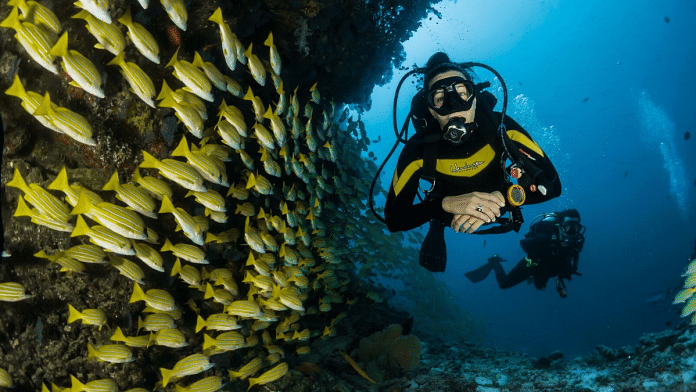The ocean is more than just water. Covering 70% of the planet’s surface, these vast marine expanses form a giant global carbon sink, help regulate our climate, generate more than half of the oxygen we breathe, give us food and medicines, provide jobs and economic benefits, help transport our goods and … the list is endless.
This is where innovation comes in. A host of new technologies are being developed that could help preserve the health of these vital planetary support systems.
To that end, the World Economic Forum’s Friends of Ocean Action initiative brings together leaders to fast-track solutions to the most pressing challenges facing our ocean.
Here are a few of the many clever ideas working to protect ocean ecosystems, including a number of initiatives from the World Economic Forum’s Uplink platform.
Marine surveillance
Identifying problems and their scale is a key part of efforts to safeguard marine environments, and several innovations are being developed to harvest ocean data.
German company Planblue is developing an “underwater satellite” to scan and map the – largely uncharted – ocean floor, for example. The robot uses AI and machine learning to navigate and its advanced imaging will give a clear picture of the impact of climate change, biodiversity loss and pollution deep beneath the waves.
In Australia, an autonomous underwater drone system called Hydrus can dive to depths of 3,000 metres below the ocean surface. Using powerful lights, it locates and identifies new marine life and monitors coral reef systems to make better conservation decisions.
Meanwhile, conservationists from global alliance Ocean Census aim to discover 100,000 new marine species using remote underwater robots. High-resolution imaging and lasers will be used in conjunction with DNA-sequencing technology to analyze traces of DNA left in ocean waters by different inhabitants.
Underwater connected technologies
Expanding our knowledge of the world’s seas and marine habitats is a key part of efforts to tackle the impact of climate change.
That’s why scientists at the EU-funded TEUTA project are working with a Croatian robotics start-up to develop lightweight, low-cost acoustic devices and robotic solutions to establish underwater wireless networks that support an Internet of Underwater Things. A network beneath the waves makes communicating in the sea easier.
The underwater connected technologies platform would harvest real-time data to help monitor and protect the world’s underwater habitats while improving under-sea communications.
Data sources could range from electronically tagged marine life to sensor-equipped shipwrecks, as part of a system of remote sensors, measuring technology, detection systems and underwater observation cameras. Harvested data would be sent to a buoy at the surface, and relayed via the cloud to shore-based researchers.
Protecting marine life
Marine life needs protection from the impact of human activity both above and beneath the waves.
As many as 30,000 whales are injured or killed annually by “ship strikes” – collisions with fishing, cargo or other marine vessels – according to the World Cetacean Alliance, with dolphins and porpoises also in danger.
But technology can help. In California, Whale Safe has deployed an acoustic buoy that can detect the sounds of whale activity and transmit a warning signal to inform shipping to slow down.
Meanwhile, Canadian start-up Whale Seeker deploys AI-powered automated drones to take aerial and infrared images that detect the presence of whales and other sea mammals. As well as preventing fatal ship strikes, the technology monitors Arctic whale populations over large areas of the ocean to minimize negative impacts.
Another innovation – by Toyon Research Corporation in the US – uses infrared cameras mounted on ships or shore sites to monitor around the clock for whale blows as they surface for air. Data showing the number, location and timing of blows helps organizations like the National Ocean Atmospheric Administration estimate whale population sizes.
Below the waves, warming ocean waters can upset the balance of marine ecosystems. A trap that sits on the Atlantic Ocean floor is being trialled to capture and control numbers of predatory lionfish, an invasive species that is threatening native marine life in some areas.
Coral protection and restoration
A lethal combination of warming ocean temperature, acidification, overfishing, pollution and other factors is causing a decline in the world’s coral reefs.

Since 2009, there has been a global decline in coral with a 14% loss of coral worldwide, equivalent to almost all blooms on Australia’s coral reefs, according to the Reef Resilience Network.
Several Uplink conservation innovations aim to halt the decline and regenerate coral populations. In Hong Kong, ArchiREEF is using 3D-printed tiles made from terracotta clay to regenerate endangered local reefs. The hexagonal tiles mimic the shape of local brain coral species to attract marine life and encourage the growth of baby corals.
A separate initiative by Coastruction uses 3-D printing to move across a bed of dry sand mix and deposit water, which activates the binder and makes it solid. Layer upon layer is added, which in time develop into complex organic shapes that imitate those found in nature. Once live corals are introduced, the result is a living reef.
As the project’s name suggests, the Plant a Million Corals Foundation aims to plant 1 million corals using “micro-fragmentation”, a technique that’s 20-40 times faster than nature. Corals are broken into pieces and, when placed in close proximity, the fragments fuse again, generating the same amount of coral in just one or two years that would take 25 years to grow naturally.
While no single innovation can safeguard the health of our ocean, the collective efforts of technologies aimed at understanding, protecting and restoring the world beneath the waves can make a difference.
This article is part of Centre for Nature and Climate.



